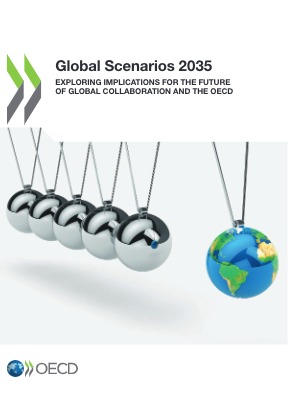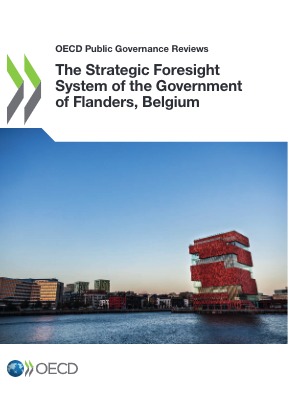Last Edited: 3 days ago
Global Scenarios 2035April 2021
Exploring Implications for the Future of Global Collaboration and the OECD
Source: OECD - Publications
In 2021, both the world and the OECD are at crossroads. The COVID-19 global pandemic has brought sudden disruption and heightened uncertainty on top of existing transformational changes such as digitalisation, geopolitical realignments, rising social inequalities and division, environmental crises and new threats to democratic governance. In this context, organisations everywhere face the challenge of modernising and adapting to remain relevant, without knowing what the future will look like or entail. The OECD in particular is entering an important period for reflection about its future, coinciding with the Organisation’s 60th anniversary and transition to a new Secretary-General.
This report uses a strategic foresight approach to inform reflection on how best to prepare the OECD to meet the needs of a highly unpredictable future. It was developed by the OECD’s Strategic Foresight Unit to demonstrate how navigating the future of global collaboration and the Organisation’s role within it will require ongoing exploration and dialogue about what may be possible, and desirable, in the future.
The report begins by exploring drivers of change that could significantly affect the future of global collaboration in public policy. For example, geopolitical realignments and heightened rivalries may undermine trust just as emerging risks to humanity make global collaboration more essential than ever before. The growing centrality of digital technologies may lead countries to develop separate digital ecosystems, threatening interconnection and interdependence between states. Platform companies are gaining significance in – and influence over – human lives, and may be poised to play an even greater role in shaping global standards and societal outcomes. Accelerated uptake of virtual reality could create new patterns of human settlement and interaction, and foster new powerful social movements and identities. Finally, an emerging bioeconomy and circular economy may transform global value chains, while a rapid expansion of private sector involvement in space opens new areas of economic activity.
Next, the report presents three scenarios for how the world could be very different than expected in 2035. While representing just three of an infinite number of possibilities, these scenarios were selected and developed for their potential to challenge current assumptions and raise important questions for the future of global collaboration and the OECD.
1.Multitrack World explores a scenario where humanity has formed into several separate and largely parallel clusters, each operating within its own data infrastructure and digital ecosystem. This scenario raises questions about how the OECD could best serve as a bridge between competing entities, and how to advance universal global principles in a context of potentially diverging values and definitions of well-being.
2.Virtual Worlds explores a scenario where the majority of human experience takes place in highly immersive and engaging virtual reality spaces, and where there is strong pressure by citizens for such spaces to be globally connected and interoperable. This scenario raises questions about what kinds of governance may be needed to address policy issues in and concerning virtual space, and what relationships with non-state actors the OECD may need in order to make an effective contribution to global collaboration in this newly dominant dimension of human life.
3.Vulnerable World explores a scenario where humanity faces a number of critical existential threats and opportunities that require an unprecedented level of near-perfect global collaboration in order to safeguard its vital common interests. This scenario raises questions of how effective governance of the global commons can be realised in these key areas, and the potential contribution of the OECD.
Taken together, these scenarios suggest a number of strategic considerations for how the OECD could prepare to meet the evolving needs of the global community in the face of a highly dynamic and uncertain future. These considerations relate to the purpose, values, representation, operations and future readiness of the Organisation.
In terms of purpose, the possibility of different future divisions and alliances in the global system suggest the OECD may need to strengthen its bridge-building role, particularly on key issues of global concern. This in turn requires an assessment of which values should guide various aspects of the Organisation’s work, with an emphasis on evidence-based analysis and well-being serving as a potential framework when working across competing economic and political systems.
In terms of representation, the OECD may need a greater ability to work closely with non-member governments and various non-state actors in a world where these have a growing influence over global policy standards and outcomes. The scenarios also raise a number of operational considerations, including ensuring the OECD’s capacity to play a leadership role in virtual space. Finally, the scenarios suggest the OECD needs to strengthen its ability to prepare for uncertainty and respond to emerging priorities such as existential threats.
The aim of this paper is to inform discussion on how best to prepare the OECD to meet the needs of a highly unpredictable future. Its intended audience is all those who have a stake and role in decisions about the future of the Organisation. This includes first and foremost member countries and OECD management and staff, but also the much broader community of countries, organisations and citizens who participate in and benefit from the activities of the OECD.
Posted on: 15/04/2025

